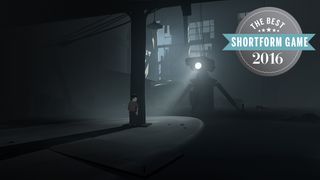
Inside wins our Best Shortform award. The gong is awarded by PC Gamer staff through voting and debate. We'll be posting an award a day leading to Christmas, along with personal picks from the PCG team. Keep up with all the awards so far here.
Chris Livingston: Inside isn’t as challenging as Playdead’s Limbo was, and I for one appreciate it. Rather than hurling myself clumsily at puzzles, dying again and again while I tried to work out exactly what the game wanted of me, I was able to complete Inside in two sessions without much frustration and thus much more freedom to soak up the details of the bizarre and nightmarish world. Those details are grimly fascinating, hinting at explanations without ever providing them.
At one point I saw one of the men pursuing me standing in a warehouse, where he was holding the hand of a child, presumably his own. It was a fascinating moment—these men chasing me, shooting me, sending dogs to tear out my throat, aren’t simply mindlessly evil pursuers but actual people with their own families and lives. I’m not saying they’re not evil—hunting down helpless children won’t win them any humanitarian awards—but to glimpse, for a moment, something decent, something human in them, gave them some complexity and personality. It was a tiny little detail, but it added a new layer to the nightmare. The animation of these tiny figures on the screen—a quick shrug of the shoulders as someone is startled by something you’ve done, or someone standing on tip-toes to peer through a window—made observing the game’s characters a fascinating experience.
Samuel: A four hour journey into an unusual, cruel and consistently surprising world. Inside's mermaid section was probably the scariest moment I encountered in a game this year—a great fusion of unsettling imagery and inventive sound design.
James Davenport: Inside’s violence is so plain, it made me wonder what it would feel like to drown, for a dog to clamp onto my neck and shake, what it would feel like to dissolve and become part of something, uh, else. All this from a side-scroller starring a faceless kid.
The use of lighting and silhouette, and most of all animation, makes almost every moment a miniature work of art.
Tony Ellis: It’s such a stark, cheerless, unfriendly setting, where men wordlessly throttle young boys to death and everything seems hopeless. And it’s presented so beautifully! The use of lighting and silhouette, and most of all animation, makes almost every moment a miniature work of art. Spending time in this bleak world, solving its puzzles and dying horribly, was a genuine pleasure.
Phil Savage: I wasn't really on board with Inside until a section, fairly late on, where you cross a bridge while avoiding potentially fatal shockwaves. As a puzzle, it's pretty good—although falls foul of Playdead's usual fondness for trial-and-error. As an atmospheric experience, though, it's marvellous. The shockwaves feel alien, and brutal, until one section—after you've solved a particular part of one puzzle—when the soundscape shifts to incorporate the noise into a tuneful ambience. It's a memorably affecting section of an intriguing and mysterious game.
PC Gamer Newsletter
Sign up to get the best content of the week, and great gaming deals, as picked by the editors.
Chris Livingston: I won’t talk too much about the final section of the game, but I enjoyed it immensely. It made me think of the citadel section of Half-Life 2, when your gravity gun abruptly gains the ability to pick up and throw soldiers around. There’s a sudden boldness that comes along with a fundamental change of what you can do in a game, when you’ve been limited in your abilities for hours and suddenly those restrictions have been removed, doubly so in a game where you are essentially helpless and vulnerable from start to finish. I found the final section of Inside cathartic as hell, transforming from a character who can only flee to becoming something people flee from. It didn’t make a whole lot of sense, at least as far as I could figure, but who cares? It was damn satisfying and a welcome change after hours of tiptoeing around, too weak to fight back.
Tim Clark: I’m still haunted by that final image on the shoreline. I think about the blob’s milky, quavering flesh, spotlighted by the moon, and try to parse exactly what Inside meant. What it wanted from me, the player. And honestly I’m not sure I’ve made much progress. Something about the terrifying monolithic power of the state, probably, which certainly feels very 2016. But beyond that I’m not sure I can coherently explain how we’re supposed to feel about seeing the kid we’ve controlled for a couple of hours getting subsumed into a wobbling ball of flab and upsettingly tiny limbs. Relieved doesn’t seem right, does it? But I’m glad Inside resists easy explanations. It’s a splinter in the brain I’m not sure I want removed.
For more musings on Inside, check out our full review.
The collective PC Gamer editorial team worked together to write this article. PC Gamer is the global authority on PC games—starting in 1993 with the magazine, and then in 2010 with this website you're currently reading. We have writers across the US, UK and Australia, who you can read about here.
Most Popular



